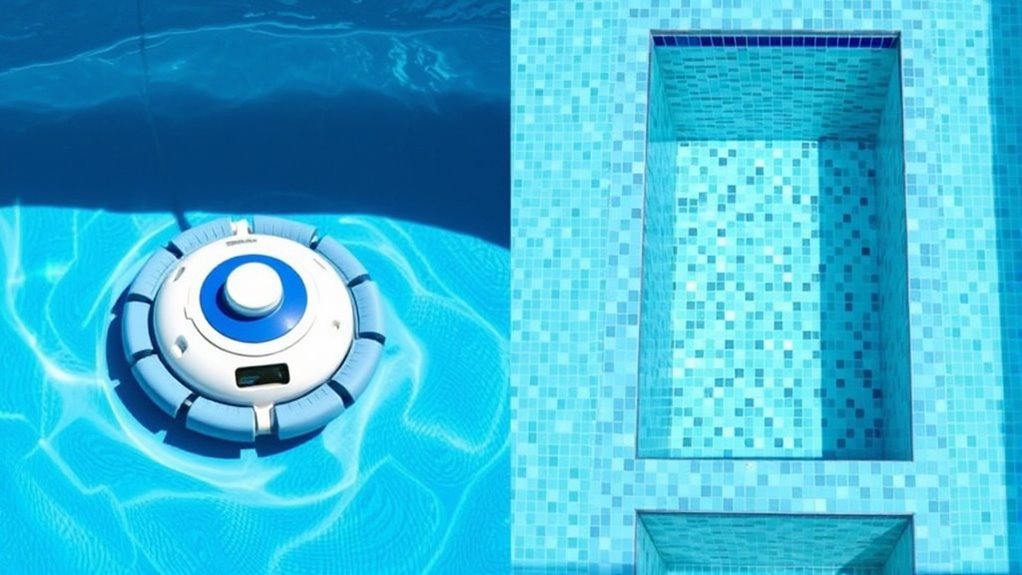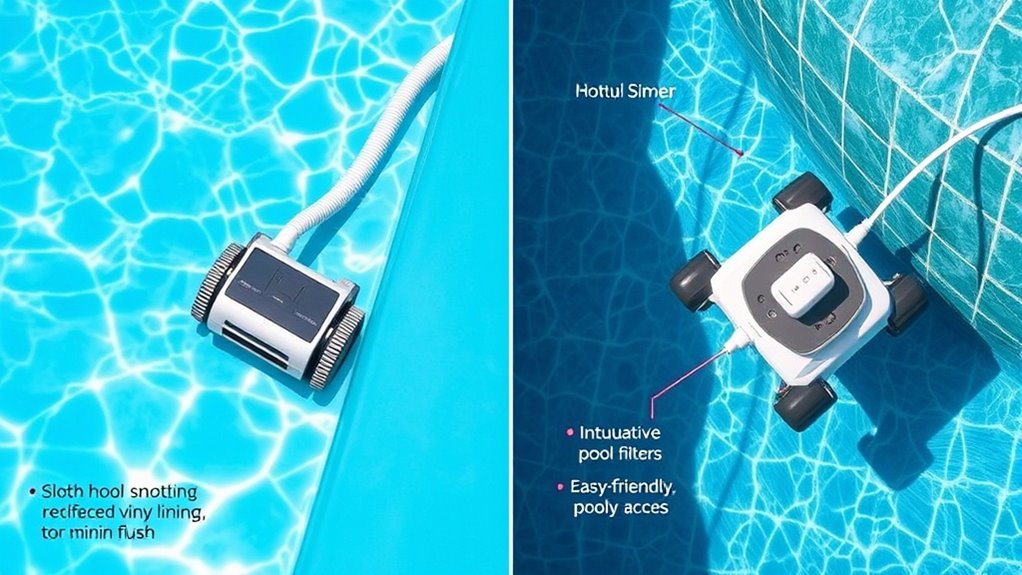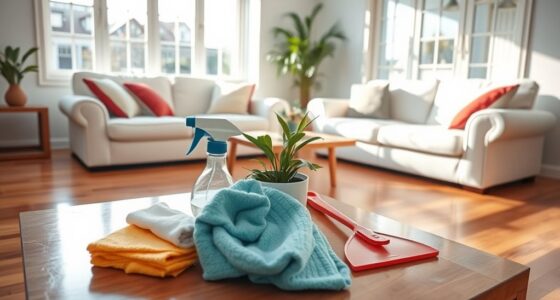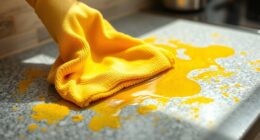Using suction pool cleaners in above-ground versus in-ground pools involves considering their compatibility, design, and installation needs. Above-ground pools are usually smaller and easier to set up, making cleaning faster and simpler, while in-ground pools are larger and more complex, requiring adjustable settings for effective cleaning. Proper setup, maintenance, and selecting the right cleaner size improve performance in both types. If you want to optimize your pool-cleaning routine, understanding these differences can help you get the best results.
Key Takeaways
- Suction pool cleaners are generally more effective in in-ground pools due to larger volume and complex shapes.
- Above-ground pools often require smaller, lightweight cleaners with adjustable steering for easier navigation.
- Surface and material compatibility are crucial; in-ground pools typically have durable surfaces suited for diverse cleaner types.
- Installation and setup are simpler for above-ground pools, often involving less complex plumbing or hose adjustments.
- Maintenance and troubleshooting tend to be more straightforward in above-ground pools because of their smaller size and simpler structure.
Compatibility of Suction Cleaners With Pool Types

Are suction pool cleaners suitable for all pool types? Not necessarily. Their compatibility depends on factors like pool chemical compatibility and the pool’s surface. Most suction cleaners work well with in-ground pools, but some models may struggle with specific surfaces or chemical balances. You need to check if the cleaner’s materials resist pool chemicals like chlorine and pH adjustments. Additionally, adjusting suction power settings is vital; too much suction can damage delicate surfaces or cause the cleaner to get stuck, while too little reduces cleaning efficiency. Proper setup and adjustments ensure your cleaner performs effectively, regardless of whether you have an above-ground or in-ground pool. Understanding material resistance is essential to choosing the right suction cleaner for your pool’s specific needs. Moreover, ensuring the compatibility with pool surfaces can prevent potential damage and improve cleaning outcomes. Furthermore, staying aware of performance tuning principles can help optimize your pool cleaning equipment’s efficiency and longevity.
Design and Construction Differences of Above-Ground and In-Ground Pools

Above-ground and in-ground pools differ markedly in their design and construction, affecting installation, durability, and maintenance. Above-ground pools are typically made from steel, resin, or vinyl, with walls designed for portability. In contrast, in-ground pools use concrete, gunite, or fiberglass, offering a more permanent structure. These differences influence water chemistry management, as in-ground pools often require more chemical balancing due to larger volumes and porous materials. The following table highlights key distinctions:
| Feature | Above-Ground Pools | In-Ground Pools |
|---|---|---|
| Pool Material | Steel, resin, vinyl | Concrete, fiberglass, gunite |
| Water Chemistry | Easier to maintain, less porous | More complex, porous surfaces |
| Construction | Portable, pre-fabricated | Custom-built on-site |
Understanding these differences helps you select and maintain your pool effectively. Pool materials play a significant role in the overall durability and upkeep of your swimming pool.
Installation and Setup Processes for Each Pool Type

Installing and setting up pools requires different approaches depending on their type, but both demand careful planning and preparation. For above-ground pools, you focus on selecting a sturdy, level surface and assembling the pool frame, ensuring the pool material is properly aligned and secure. In contrast, in-ground pools involve more complex groundwork, like excavation and proper drainage setup. Regardless of type, maintaining ideal water chemistry during setup is essential to prevent issues like algae growth or staining. When installing suction pool cleaners, confirm that the skimmer and suction lines are clear and compatible with the pool material. Proper setup ensures efficient operation, reduces leaks, and promotes long-term durability. Pay close attention to manufacturer instructions for each pool type to guarantee a seamless installation process. Additionally, choosing the right projector technology can significantly enhance your viewing experience, whether for entertainment or presentations.
Performance Efficiency in Different Pool Environments

The effectiveness of suction pool cleaners can vary markedly depending on the environment in which they operate. In above-ground pools, the typically smaller size and simpler shape allow for better suction power, resulting in faster cleaning speeds. You’ll likely find that these cleaners move efficiently across the pool surface, covering more area quickly. In contrast, in-ground pools often have complex shapes and larger volumes, which can reduce suction power and slow down cleaning speed. You may notice the cleaner takes longer to complete its cycle or misses certain spots. To optimize performance, ensure your suction power is adequate for your pool size and shape. Adjusting the cleaner’s settings or using models designed for specific environments can notably improve cleaning efficiency. Additionally, considering the design and materials used in textile art can inspire creative ways to enhance pool aesthetics or maintenance accessories. For optimal results, it’s important to match the suction power of your cleaner with the specific demands of your pool environment.
Maintenance and Troubleshooting Considerations

To keep your suction pool cleaner running smoothly, you need to contemplate pool size compatibility and avoid overworking the device. Regularly check for debris blockages to prevent clogs that could hinder performance. Following simple maintenance tips can help you troubleshoot issues quickly and keep your cleaner operating efficiently. Additionally, understanding affiliate disclosure policies can help you make informed decisions when purchasing replacement parts or accessories. Recognizing trust issues within your relationship can also inform your approach to maintenance and troubleshooting, ensuring a smoother experience overall. Considering filter replacement indicators and how they alert you when filters need changing is essential for maintaining peak performance. Incorporating sound healing science insights, like listening to calming music during cleaning routines, can further enhance your pool maintenance experience. Moreover, staying updated on industry transformations such as advancements in AI automation can inspire more efficient maintenance techniques.
Pool Size Compatibility
Choosing a suction pool cleaner that matches your pool size is essential for effective maintenance and troubleshooting. If your pool is too large for the cleaner’s capacity, it may struggle to cover the entire surface, leading to missed spots and uneven cleaning. Conversely, an undersized cleaner can become inefficient, wasting energy and making your pool maintenance more difficult. Properly matching the cleaner guarantees it can handle your pool’s volume without strain. Additionally, consider how pool water chemistry affects your cleaner’s performance and longevity, especially if you have advanced pool lighting options that might influence water circulation. Ensuring compatibility helps maintain balanced water chemistry, reducing wear on the cleaner and making troubleshooting easier when issues arise.
Debris Blockage Prevention
Regularly inspecting and clearing debris from your suction pool cleaner’s intake and filter basket prevents blockages that can impair performance. Debris blockage is a common issue that reduces suction power and cleaning efficiency. To prevent clogs, remove leaves, dirt, and other debris promptly, especially after storms or heavy use. Check the intake and filter basket frequently, ensuring they aren’t overflowing or clogged. If you notice reduced suction or the cleaner stalling, it’s often due to debris buildup. Clear any obstructions immediately to restore ideal operation. Proper clog prevention extends the lifespan of your cleaner and maintains consistent cleaning. Additionally, being aware of pump and filter maintenance can help prevent pressure issues that contribute to clogs and performance problems. Regularly inspecting the filter system also helps identify potential issues before they cause significant blockages. Incorporating routine vacuum cleaner troubleshooting can further ensure optimal operation and longevity of your pool cleaning equipment. For enhanced efficiency, consider upgrading your pool equipment to newer, more clog-resistant models. Performing system checks periodically can help identify developing issues before they impact cleaning performance.
Regular Maintenance Tips
Maintaining your suction pool cleaner involves more than just clearing debris; it requires routine checks and timely troubleshooting. Regularly inspect hoses, fittings, and the pump to verify everything operates smoothly. Check the chemical balance of your pool water; improper levels can affect the cleaner’s performance and cause buildup or corrosion. Keep an eye on the filter and clean or replace it as needed. If you’re preparing for seasonal shutdown, give your cleaner a thorough cleaning and store it in a dry, protected area. During the off-season, disconnect and clean all parts to prevent damage. Consistent maintenance helps prevent issues, extends the lifespan of your cleaner, and ensures it functions efficiently when you need it most. Additionally, understanding air quality signs can inspire confidence that love and harmony are on their way, even during routine pool maintenance. Regularly consulting pool maintenance guidelines can also enhance your understanding of proper care and troubleshooting. Incorporating proper equipment handling techniques can further reduce the risk of damage and improve overall performance. Being aware of store hours for your local pool supply stores can help you plan for necessary replacements or supplies when needed.
Cost Implications for Different Pool Types

The cost of using suction pool cleaners varies considerably depending on the type of pool you have. With above-ground pools, you’ll generally spend less upfront on the cleaner itself and save on installation costs. However, maintaining proper pool chemistry and managing water temperature can influence ongoing expenses, since these factors affect how often you need to run the cleaner and replace parts. In-ground pools tend to require more investment initially and may demand more frequent maintenance, especially if water chemistry fluctuates or temperatures change seasonally. Additionally, the larger size and complexity of in-ground pools mean longer cleaning cycles, which can increase energy and water use. Balancing these factors helps you determine the true cost implications for each pool type.
Compatibility With Pool Shapes and Sizes

Choosing a suction pool cleaner that fits your pool’s shape and size guarantees efficient cleaning and minimizes frustration. Look for options with good shape adaptability and size flexibility to guarantee it covers every corner effectively. For irregularly shaped pools, select a cleaner with adjustable steering to navigate curves smoothly. In larger pools, prioritize models with extended hoses for thorough coverage without frequent repositioning. For small or compact pools, choose a compact cleaner that’s easy to maneuver within tight spaces. Additionally, consider the reservoir system of the cleaner to ensure consistent performance across different pool configurations. Understanding the pool size helps in selecting a model with the appropriate suction power and coverage capacity. Considering the exfoliation benefits of glycolic acid can also enhance your poolside skincare routine, ensuring your skin remains vibrant and smooth after pool sessions. Being aware of the suction power and how it correlates with pool size further ensures optimal cleaning efficiency for your specific pool type.
Ease of Use and Operation Features

You’ll find that easy access to the cleaner and strategic placement make setup straightforward. With intuitive controls and smooth navigation, operating the cleaner becomes hassle-free. These features guarantee you spend less time managing the device and more time enjoying a clean pool. Additionally, understanding cost-effective options can help you choose the right cleaner for your pool size and type.
Accessibility and Placement
Suction pool cleaners are designed to be user-friendly, but their accessibility and placement can markedly impact how easily you operate them. Accessibility challenges, such as tight spaces or uneven surfaces, can make setup and maintenance frustrating. Proper placement strategies are essential to guarantee effective cleaning and prevent tangles or blockages. For example, positioning the hose away from obstacles helps maintain smooth operation. Consider these points:
- Ensure the hose is long enough to reach all areas without stretching or kinking.
- Position the cleaner in open, unobstructed areas for optimal movement.
- Check for easy access to the filter and hoses for quick maintenance.
Control and Navigation
Control and navigation are key to making your pool cleaning experience straightforward and effective. Modern suction pool cleaners often feature advanced sensor technology that helps them map and adapt to your pool’s shape, ensuring thorough coverage without getting stuck. These sensors enable the cleaner to detect obstacles and adjust its path automatically, saving you time and effort. Power sources vary, with some models operating on corded electric power for consistent performance, while others use rechargeable batteries for added convenience and ease of movement. Ease of operation is enhanced when the cleaner’s controls are simple and intuitive, allowing you to start, stop, or schedule cleanings effortlessly. Overall, smart control and navigation features make maintaining your pool less of a chore and more of an automated process.
Longevity and Durability of Suction Cleaners

While suction pool cleaners are generally designed to last for several seasons, their longevity depends heavily on proper maintenance and usage. The materials used in construction, such as durable plastics and corrosion-resistant metals, play a key role in how long your cleaner will perform well. Quality units often come with warranty coverage that protects against manufacturing defects, giving you peace of mind. To ensure maximum durability, regularly inspect hoses and brushes for wear and tear. Proper storage during the off-season also helps prevent damage. Keep in mind that cheaper models may not offer the same lifespan, so investing in a reputable brand can pay off. Ultimately, taking good care of your cleaner extends its lifespan and maintains its cleaning efficiency over time.
Tips for Optimizing Cleaning Results in Both Pool Types

To get the best cleaning results, you should start by adjusting your cleaner’s settings to match your pool’s needs. Keeping the pool surface smooth helps prevent obstructions and improves efficiency. Also, choosing the right cleaner size guarantees thorough coverage without overloading your system.
Adjust Cleaning Settings Properly
Adjusting your suction pool cleaner’s settings correctly is essential for achieving ideal cleaning results in both inground and above-ground pools. Proper adjusting of settings ensures maximum cleaning calibration, helping the cleaner pick up debris effectively. To do this:
- Check the flow rate and adjust the valve to balance suction without losing power.
- Set the cleaner’s brushes and wheels to match your pool’s surface for better maneuverability.
- Test the cleaning cycle duration, increasing it if necessary to cover all areas thoroughly.
Maintain Pool Surface Smoothly
Maintaining a smooth pool surface is key to maximizing your suction cleaner’s efficiency. When the surface is even, water circulation improves, allowing the cleaner to move seamlessly and pick up debris more effectively. To achieve this, regularly skim the surface to remove leaves and floating dirt, preventing buildup that can disrupt water flow. Keep your water levels balanced; too high or low levels hinder circulation and cleaning performance. Check for and fix any surface irregularities like algae patches or uneven spots, which can trap debris or block water flow. Good water circulation ensures debris doesn’t settle and that your suction cleaner operates at peak performance. Consistent surface maintenance creates an ideal environment for thorough cleaning, whether you have an above-ground or in-ground pool.
Select Suitable Cleaner Size
Choosing the right-sized suction pool cleaner is essential for effective cleaning in both above-ground and in-ground pools. A cleaner that’s too small may miss debris, while one that’s too large can strain your pool’s pump. When selecting size, consider your pool’s shape and size, as well as your preferred cleaning pace.
- Think about pool color options; darker pools may hide dirt better, so a more powerful cleaner might be needed.
- Read user reviews to see how different sizes perform in pools similar to yours.
- Guarantee the cleaner fits comfortably within your pool’s dimensions without causing obstructions or tangles.
Matching the cleaner size to your pool ensures thorough cleaning and prolongs equipment life, making your pool maintenance much easier.
Frequently Asked Questions
Can Suction Pool Cleaners Be Used Effectively in Saltwater Pools?
Yes, suction pool cleaners work effectively in saltwater pools. They’re saltwater compatible, meaning the salt won’t damage their components. You’ll notice good cleaning efficiency as they pick up debris and dirt just as well as in freshwater pools. Just make certain you choose a model designed for saltwater use, and regularly check and maintain the cleaner to prevent corrosion and keep it running smoothly.
Are There Specific Safety Precautions When Using Suction Cleaners in Different Pools?
When using suction pool cleaners, you should follow safety precautions like keeping a pool cover secure when not in use and posting safety signage to warn others. Always check for any debris or hazards before starting, and make certain the cleaner is properly attached. In saltwater pools, monitor salt levels to prevent damage. By taking these steps, you keep everyone safe and protect your equipment regardless of your pool type.
How Do Suction Cleaners Handle Debris of Varying Sizes in Each Pool Type?
Did you know suction cleaners can handle up to 90% of debris? When it comes to debris size, these cleaners excel at capturing both small leaves and larger twigs, thanks to their adjustable suction power. Filtration efficiency varies depending on debris size; finer particles are filtered better in in-ground pools with advanced filters, while above-ground pools might struggle with larger debris if the cleaner’s suction isn’t strong enough.
Do Suction Cleaners Require Different Maintenance Routines for Above-Ground vs. In-Ground Pools?
You’ll need to adjust your maintenance routine based on your pool surface and cleaning accessories. For above-ground pools, check filters and hoses regularly, especially if debris is larger. In in-ground pools, focus on cleaning the pool surface more often and inspecting the suction cleaner’s parts. Both require routine filter cleaning and hose checks, but in-ground pools might need more frequent maintenance due to larger debris buildup.
Can Suction Cleaners Operate Efficiently in Pools With Irregular or Complex Shapes?
You might wonder if suction cleaners work well in pools with irregular shapes or complex designs. They can, but you need to make certain the cleaner’s design matches your pool’s shape. For irregular or intricate layouts, a cleaner with adjustable or flexible features helps it navigate corners and tight spots efficiently. Regularly checking the brushes and hoses will keep it operating smoothly, ensuring your pool stays clean regardless of its shape or design.
Conclusion
Now that you know the differences between using suction pool cleaners in above-ground and in-ground pools, you might be wondering which setup will truly maximize your cleaning efficiency. The choice isn’t always clear-cut, and your pool’s unique features could hold the key. Ready to make the best decision? Stay tuned—your perfect pool cleaning solution could be closer than you think, just waiting for you to uncover it.










